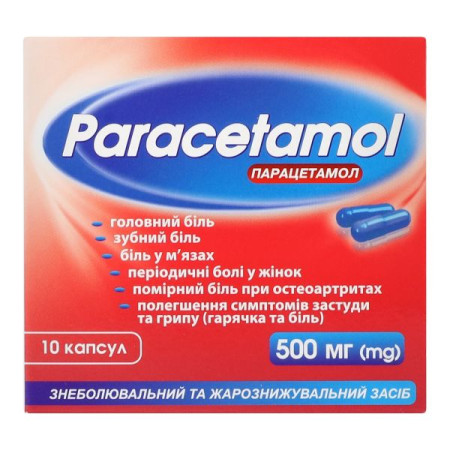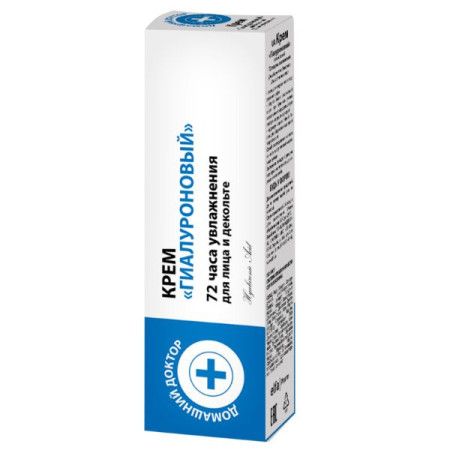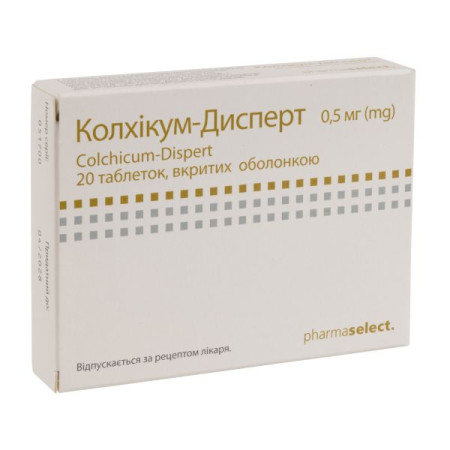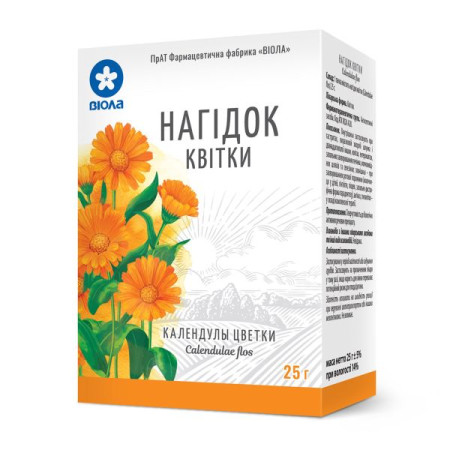Acetylsalicylic acid-Darnitsa tablets 500 mg No. 10
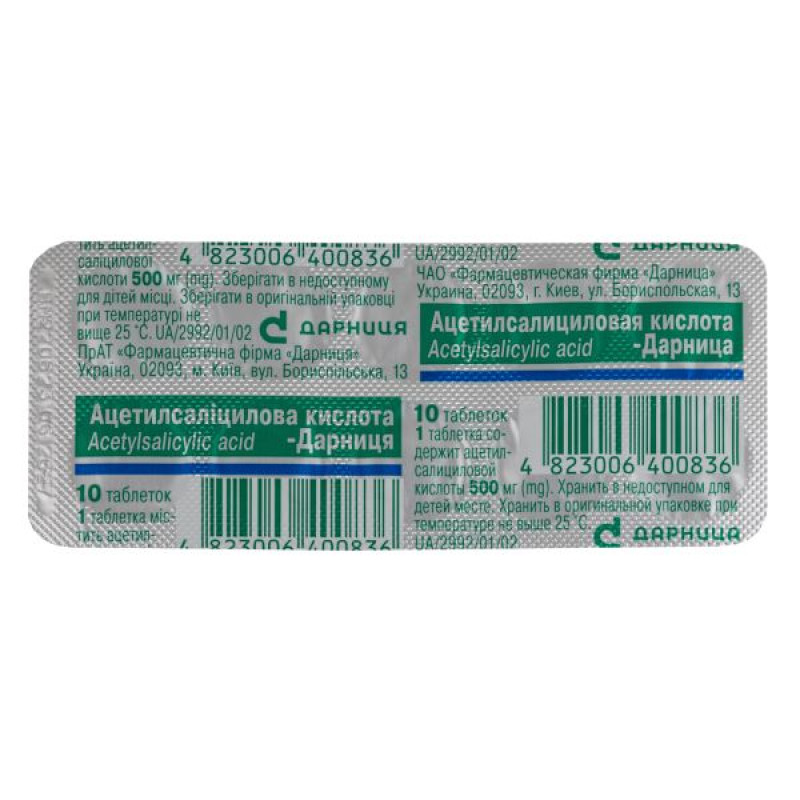
Instructions for use: Acetylsalicylic acid-Darnitsa tablets 500 mg No. 10
Composition
active ingredient: acetylsalicylic acid;
1 tablet contains acetylsalicylic acid 500 mg;
Excipients: citric acid monohydrate, potato starch.
Dosage form
Pills.
Main physicochemical properties: white tablets of flat-cylindrical shape, with a bevel and a score.
Pharmacotherapeutic group
Analgesics and antipyretics. Acetylsalicylic acid. ATX code N02B A01.
Pharmacological properties
Pharmacodynamics
Acetylsalicylic acid is a nonsteroidal anti-inflammatory drug (NSAID), a salicylate derivative. The main mechanism of action of acetylsalicylic acid is the inactivation of the COX enzyme (cyclooxygenase), which reduces the production of inflammatory mediators: prostaglandins, prostacyclins and thromboxane. A decrease in the synthesis of prostaglandins leads to a decrease in their effect on thermoregulation centers, which leads to a decrease in the temperature increased due to inflammation. Reduces the sensitizing effect of prostaglandins on pain-sensitive nerve endings, which reduces their sensitivity to pain mediators. Irreversible inhibition of thromboxane A2 synthesis in platelets causes the antiplatelet effect of acetylsalicylic acid.
The pharmacodynamics of acetylsalicylic acid depends on the daily dose:
small doses – 30−325 mg – cause inhibition of platelet aggregation;
medium doses – 1.5−2 g – have an analgesic and antipyretic effect;
Large doses – 4 g – have an anti-inflammatory effect.
At a dose of less than 4 g, acetylsalicylic acid delays the excretion of uric acid.
Pharmacokinetics
When taken orally, it is almost completely absorbed from the gastrointestinal tract (GI). The time to reach maximum plasma concentration (Tmax) is 10−20 minutes. Tmax of total salicylate formed as a result of metabolism is 0.3−2 hours. The degree of binding to plasma proteins is 49−70%. It is metabolized by 50% during the first pass through the liver. A glycyl conjugate of salicylic acid is formed. It is excreted from the body by the kidneys in the form of metabolites. The half-life (T1/2) is 20 minutes. T1/2 for salicylic acid is approximately 2 hours. Penetrates into breast milk, synovial fluid, and cerebrospinal fluid.
Indication
Treatment of mild to moderately severe, acute pain syndrome (headache, toothache, joint and ligament pain, back pain). Symptomatic treatment of fever and/or pain syndrome in colds.
Contraindication
Hypersensitivity to acetylsalicylic acid, other salicylates or to any of the excipients of the drug. Bronchial asthma caused by the use of salicylates or other NSAIDs in history. Acute gastrointestinal ulcers. Hemorrhagic diathesis. Severe renal failure. Severe hepatic failure. Severe heart failure.
Combined use with methotrexate at a dosage of 15 mg per week or more (see section "Interaction with other medicinal products and other types of interactions").
Interaction with other medicinal products and other types of interactions
Contraindications for simultaneous use.
The use of acetylsalicylic acid and methotrexate in doses of 15 mg/week or more increases hematological toxicity (reduction in renal clearance of methotrexate by anti-inflammatory agents and displacement of methotrexate from plasma protein binding by salicylates).
Combinations that should be used with caution.
When using acetylsalicylic acid and methotrexate in doses less than 15 mg/week, the hematological toxicity of methotrexate increases (reduction in renal clearance of methotrexate by anti-inflammatory agents and displacement of methotrexate from plasma protein binding by salicylates).
Concomitant use of acetylsalicylic acid with ibuprofen prevents irreversible inhibition of platelets by acetylsalicylic acid. Treatment of patients at risk of cardiovascular disease with ibuprofen may limit the cardioprotective effect of acetylsalicylic acid.
The risk of bleeding increases with the simultaneous use of acetylsalicylic acid and anticoagulants, thrombolytics/other inhibitors of platelet aggregation/hemostasis.
The simultaneous use of high doses of salicylates with NSAIDs (due to a mutual enhancing effect) increases the risk of ulcers and gastrointestinal bleeding.
When used with selective serotonin reuptake inhibitors, the risk of gastrointestinal bleeding increases due to a possible synergistic effect.
When used simultaneously with digoxin, the concentration of the latter in plasma increases due to reduced renal excretion.
With the simultaneous use of high doses of acetylsalicylic acid and antidiabetic drugs from the group of sulfonylurea derivatives or insulin, the hypoglycemic effect of the latter is enhanced due to the displacement of sulfonylurea bound to plasma proteins by acetylsalicylic acid.
Systemic glucocorticosteroids (including hydrocortisone, which is used for replacement therapy in Addison's disease) reduce the level of salicylates in the blood and increase the risk of overdose after the end of treatment, as well as the risk of gastrointestinal bleeding.
Angiotensin-converting enzymes (ACE) in combination with high doses of acetylsalicylic acid cause a decrease in glomerular filtration due to inhibition of the vasodilator effect of prostaglandins and a decrease in the antihypertensive effect.
When used simultaneously with valproic acid, acetylsalicylic acid displaces it from its association with plasma proteins, increasing the toxicity of the latter.
Alcohol causes damage to the gastrointestinal mucosa and prolongs bleeding time due to the synergism of acetylsalicylic acid and alcohol.
Concomitant use with uricosuric agents such as benzobromarone, probenecid reduces the effect of uric acid excretion (due to competition for uric acid excretion by the renal tubules).
Application features
Acetylsalicylic acid-Darnitsa should be used with extreme caution in the following cases:
individual hypersensitivity to analgesic, anti-inflammatory, antirheumatic drugs and the presence of other types of allergies; history of gastrointestinal ulcers, as well as chronic or recurrent peptic ulcer disease or gastrointestinal bleeding in history; concomitant treatment with anticoagulants; impaired liver function.
The drug should also be used with caution in patients with impaired renal function or patients with circulatory disorders (e.g. renal vascular pathology, congestive heart failure, hypovolemia, extensive surgery, sepsis or significant blood loss), since acetylsalicylic acid may also increase the risk of renal dysfunction and acute renal failure. In patients with severe glucose-6-phosphate dehydrogenase deficiency, acetylsalicylic acid may cause hemolysis or hemolytic anemia, especially in the presence of factors that may increase the risk of hemolysis, such as high doses of the drug, fever or acute infectious process.
In patients with allergic complications, including bronchial asthma, allergic rhinitis, urticaria, skin itching, mucosal edema and nasal polyposis, as well as in combination with chronic respiratory tract infections and in patients with hypersensitivity to NSAIDs, the development of bronchospasm or an attack of bronchial asthma, or other hypersensitivity reactions, is possible when using the drug.
During surgical operations (including dental), the use of drugs containing acetylsalicylic acid may increase the likelihood of bleeding due to inhibition of platelet aggregation for some time after the use of acetylsalicylic acid.
In low doses, acetylsalicylic acid may reduce the excretion of uric acid. This may lead to the development of gout in patients with reduced uric acid excretion.
If used, the patient should consult a doctor before starting to take ibuprofen as a painkiller.
Prolonged use of analgesics can lead to headaches.
Frequent use of painkillers can cause temporary kidney damage with the risk of developing kidney failure (analgesic nephropathy). The risk is higher when several different analgesics are used simultaneously.
Ability to influence reaction speed when driving vehicles or other mechanisms
No effect on the ability to drive or use other mechanisms was noted.
Use during pregnancy or breastfeeding
Inhibition of prostaglandin synthesis may adversely affect pregnancy and/or embryonal/fetal development. Available epidemiological data indicate a risk of miscarriage and foetal malformations after the use of prostaglandin synthesis inhibitors in early pregnancy. The risk increases with increasing dose and duration of therapy. Available epidemiological data do not support an association between the use of acetylsalicylic acid and an increased risk of miscarriage. The data on malformations are not consistent, but an increased risk of gastroschisis cannot be excluded with the use of the medicinal product. The results of a prospective study of the effects on early pregnancy (1-4 months) involving approximately 14,800 mother-child pairs do not indicate any association with an increased risk of malformations.
Animal studies indicate reproductive toxicity.
During the first and second trimesters of pregnancy, preparations containing acetylsalicylic acid should not be prescribed unless clearly necessary. In women who may be pregnant or who are pregnant in the first and second trimesters of pregnancy, the dose of preparations containing acetylsalicylic acid should be as low as possible and the duration of treatment as short as possible.
During the third trimester of pregnancy, salicylates may affect the fetus in the following ways:
Salicylates can affect a woman and her baby at the end of pregnancy in the following ways:
Possible prolongation of bleeding time, antiplatelet effect, which may occur even after very low doses; inhibition of uterine contractions, which may lead to delayed or prolonged labor.
The use of acetylsalicylic acid in large doses shortly before delivery can lead to intracranial bleeding, especially in premature babies.
Given this, acetylsalicylic acid is contraindicated during the third trimester of pregnancy.
Salicylates and their metabolites pass into breast milk in small amounts.
Since no harmful effects on the child have been observed after administration to lactating women, breastfeeding should not be interrupted. However, in cases of regular use or when using high doses, breastfeeding should be discontinued early.
Method of administration and doses
The medicine should be taken orally after meals, with sufficient liquid. It should not be used for longer than 3-5 days without consulting a doctor.
Adults and children aged 15 and over.
500-1000 mg as a single dose. Repeated administration is possible after 4-8 hours. The maximum daily dose should not exceed 4 g.
Warning
For patients with concomitant liver or kidney dysfunction, it is necessary to reduce the dose of the drug or increase the interval between applications.
Children
The medicine should be used in children over 15 years of age.
Acetylsalicylic acid-containing drugs should not be used in children with acute respiratory viral infections (ARI) with or without fever. Some viral diseases, especially influenza A, influenza B and chickenpox, carry a risk of developing Reye's syndrome, which is a very rare but life-threatening illness requiring immediate medical attention. The risk may be increased if acetylsalicylic acid is used as a concomitant medication, but a causal relationship has not been proven in this case. If these conditions are accompanied by prolonged vomiting, this may be a sign of Reye's syndrome.
Overdose
Salicylate overdose is possible due to chronic intoxication resulting from long-term therapy (administration of more than 100 mg/kg/day for more than 2 days may cause toxic effects), as well as due to acute, potentially life-threatening intoxication (overdose), the causes of which may be, for example, accidental use by children or unintentional overdose.
Chronic salicylate poisoning can be insidious because its signs are nonspecific. Moderate chronic salicylate intoxication, or salicylism, usually occurs only after repeated use of large doses.
Symptoms: balance disorders, dizziness, tinnitus, deafness, increased sweating, tachypnea, nausea, vomiting, headache, confusion. These symptoms can be controlled by reducing the dose. Tinnitus may occur at plasma concentrations of 150 to 300 μg/ml. More serious adverse reactions occur at concentrations above 300 μg/ml.
Acute intoxication is indicated by a pronounced change in acid-base balance, which may vary depending on age and severity of intoxication. The most common sign in children is metabolic acidosis. The severity of the condition cannot be assessed solely on the basis of the concentration of salicylates in the blood plasma. The absorption of acetylsalicylic acid may be slowed down due to delayed gastric emptying, the formation of concrements in the stomach, or the use of enteric-coated preparations.
Moderate to severe intoxication is manifested by respiratory alkalosis, accompanied by compensatory metabolic acidosis, hyperpyrexia. From the respiratory system: from hyperpnea, non-cardiogenic pulmonary edema to respiratory arrest and asphyxia. From the cardiovascular system: from arrhythmia, arterial hypotension to cardiac arrest. Dehydration, oliguria up to renal failure are also observed; impaired glucose metabolism, ketosis; gastrointestinal bleeding; hematological changes - from platelet suppression to coagulopathies. From the nervous system: toxic encephalopathy and CNS depression, manifested as drowsiness, depression of consciousness up to the development of coma and seizures.
Changes in laboratory and other parameters: alkalemia, alkaluria, acidemia, aciduria, changes in blood pressure, changes in ECG, hypokalemia, hypernatremia, hyponatremia, changes in renal function, hyperglycemia, hypoglycemia (especially in children); increased levels of ketone bodies, hypoprothrombinemia.
Manifestations and symptoms/test results due to the complex pathophysiological effects of salicylate poisoning and necessary therapeutic measures:
| Manifestations and symptoms | Test results | Therapeutic measures |
| Mild or moderate intoxication | Gastric lavage, administration of activated charcoal, forced alkaline diuresis | |
| Tachypnea, hyperventilation, respiratory alkalosis | Alkalemia, alkaluria | Restoration of electrolyte and acid-base balance |
| Diaphoresis (increased sweating) | ||
| Nausea, vomiting | ||
| Moderate or severe intoxication | Gastric lavage, administration of activated charcoal, forced alkaline diuresis, hemodialysis in severe cases | |
| Respiratory alkalosis with compensatory metabolic acidosis | Acidemia, aciduria | Restoration of electrolyte and acid-base balance |
| Hyperpyrexia | Restoration of electrolyte and acid-base balance | |
| Respiratory: hyperventilation, noncardiogenic pulmonary edema, respiratory failure, asphyxia | ||
| Cardiovascular: dysarrhythmias, hypotension, cardiovascular failure | Changes in blood pressure, ECG | |
| Fluid and electrolyte loss: dehydration, oliguria, renal failure | Hypokalemia, hypernatremia, hyponatremia, changes in renal function | Restoration of electrolyte and acid-base balance |
| Impaired glucose metabolism, ketoacidosis | Hyperglycemia, hypoglycemia (especially in children); elevated ketone bodies | |
| Ringing in the ears, deafness | ||
| Gastrointestinal: GI bleeding | ||
| Hematologic: platelet inhibition, coagulopathy | Prolonged bleeding time, hypoprothrombinemia | |
| Neurological: toxic encephalopathy and CNS depression with manifestations such as lethargy, confusion, coma and seizures |
Adverse reactions
From the side of the organs of hearing and vestibular apparatus: tinnitus, hearing loss.
From the respiratory system, thoracic organs and mediastinum: rhinitis, asthma, triad (eosinophilic rhinitis, recurrent nasal polyposis, hyperplastic sinusitis), non-cardiogenic pulmonary edema.
On the part of the gastrointestinal tract: dyspepsia, heartburn, vomiting, nausea, epigastric pain, diarrhea, ulcerogenic effect, erosive and ulcerative lesions of the gastric and duodenal mucosa, gastrointestinal bleeding and gastrointestinal perforation with corresponding clinical symptoms and changes in laboratory parameters (microhemorrhages, melena).
Liver and biliary tract disorders: liver dysfunction, hepatogenic encephalopathy, transient hepatic failure with increased liver transaminase levels.
Renal and urinary disorders: Kidney damage and acute renal failure have been reported.
From the side of metabolism: hypoglycemia.
Nervous system: dizziness, tinnitus, headache, loss of consciousness, convulsions, collapse, aseptic meningitis.
From the blood and lymphatic system: thrombocytopenia, anemia, leukopenia, eosinophilia, hemorrhagic syndrome, hypoprothrombinemia.
Due to its antiplatelet effect on platelets, acetylsalicylic acid may increase the risk of bleeding. Bleeding events such as intraoperative hemorrhages, hematomas, genitourinary bleeding, epistaxis, gingival bleeding have been observed; rarely or very rarely, serious bleeding events such as gastrointestinal bleeding and cerebral hemorrhages (especially in patients with uncontrolled arterial hypertension and/or concomitant use of antihemostatic agents), which in isolated cases could be potentially life-threatening.
Bleeding can lead to acute and chronic posthemorrhagic anemia/iron deficiency anemia (due to so-called occult microbleeding) with corresponding laboratory manifestations and clinical symptoms such as asthenia, pallor of the skin, hypoperfusion.
Hemolysis and the development of hemolytic anemia have been reported in patients with severe glucose-6-phosphate dehydrogenase deficiency.
On the part of the immune system: hypersensitivity reactions, including urticaria and skin rashes, itching, angioedema, anaphylactic shock, decreased blood pressure, nasal congestion, asthma, bronchospasm; in patients with bronchial asthma, there is an increase in the frequency and severity of attacks, toxic epidermal necrolysis; allergic reactions of mild to moderate severity, potentially affecting the skin, respiratory system, gastrointestinal tract and cardiovascular system.
Expiration date
4 years.
Storage conditions
Store in the original packaging at a temperature not exceeding 25 °C.
Keep out of reach of children.
Packaging
10 tablets in a blister.
Vacation category
Without a prescription.
Producer
PrJSC "Pharmaceutical Company "Darnitsa".
Ukraine, 02093, Kyiv, Boryspilska St., 13.
There are no reviews for this product.
There are no reviews for this product, be the first to leave your review.
No questions about this product, be the first and ask your question.




